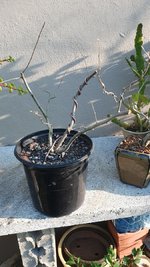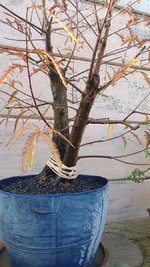CapeCodBonsai
Shohin
I feel like “New, Uncommon, or Unusual” (in terms of the bonsai world) is kinda difficult to venture into these days. The more I Google, the more I realize just about every woody species has been tried. I am growing several things that were difficult (for me) to find on Cape Cod in nurseries so therefore, they are “Uncommon” (to me):
Chinese Coffin Tree (Taiwania cryptomerioides)
Sassafras (Sassafras albidum)
Blackthorn (Prunus spinosa)
Temple Juniper (Juniperus rigida)
Rowan/European Mountain Ash (Sorbus aucuparia)
Siberian peashrub/Siberian pea-tree (Caragana arborescens)
Yellowhorn (Xanthoceras sorbifolium)
American Dwarf Birch (Betula Glandulosa)
Willow Hawthorn (Crataegus saligna)
Koyama Spruce (Picea Koyamae)
Alder-Leaf Mountain Mahogany (Cercocarpus montanus)
David Elm (Ulmus davidiana)
Japanese Raisin Tree (Hovenia dulcis)
Hardy Rosewood (Dalbergia hupeana)
Japanese prickly-ash (Zanthoxylum piperitum)
Cornelian Cherry (Cornus mas)
Katsura (Cercidiphyllum japonicum)
Sea Buckthorn (Hippophae rhamnoides)
Kadsura (Kadsura japonica)
. . . and when it comes to some of the species that would qualify as “Weird” and “Controversial” because they will likely never work as a convincing bonsai (due to foliage, habit, . . . Etc.) but, experimenting with it anyway:
Common Medlar (Mespilus germanica)
Elegant Maple (Acer elegantulum)
Franklin Tree (Franklinia alatamaha)
Dutchman's Pipe (Aristolochia macrophylla)
Chinese Parasol Tree (Firmiana simplex)
Japanese umbrella-pine (Sciadopitys verticillata)
American papaw (Asimina triloba)
If anyone has bonsai’d any of these species and is willing to share notes and photos, please send me a message.
Chinese Coffin Tree (Taiwania cryptomerioides)
Sassafras (Sassafras albidum)
Blackthorn (Prunus spinosa)
Temple Juniper (Juniperus rigida)
Rowan/European Mountain Ash (Sorbus aucuparia)
Siberian peashrub/Siberian pea-tree (Caragana arborescens)
Yellowhorn (Xanthoceras sorbifolium)
American Dwarf Birch (Betula Glandulosa)
Willow Hawthorn (Crataegus saligna)
Koyama Spruce (Picea Koyamae)
Alder-Leaf Mountain Mahogany (Cercocarpus montanus)
David Elm (Ulmus davidiana)
Japanese Raisin Tree (Hovenia dulcis)
Hardy Rosewood (Dalbergia hupeana)
Japanese prickly-ash (Zanthoxylum piperitum)
Cornelian Cherry (Cornus mas)
Katsura (Cercidiphyllum japonicum)
Sea Buckthorn (Hippophae rhamnoides)
Kadsura (Kadsura japonica)
. . . and when it comes to some of the species that would qualify as “Weird” and “Controversial” because they will likely never work as a convincing bonsai (due to foliage, habit, . . . Etc.) but, experimenting with it anyway:
Common Medlar (Mespilus germanica)
Elegant Maple (Acer elegantulum)
Franklin Tree (Franklinia alatamaha)
Dutchman's Pipe (Aristolochia macrophylla)
Chinese Parasol Tree (Firmiana simplex)
Japanese umbrella-pine (Sciadopitys verticillata)
American papaw (Asimina triloba)
If anyone has bonsai’d any of these species and is willing to share notes and photos, please send me a message.
Last edited:

















